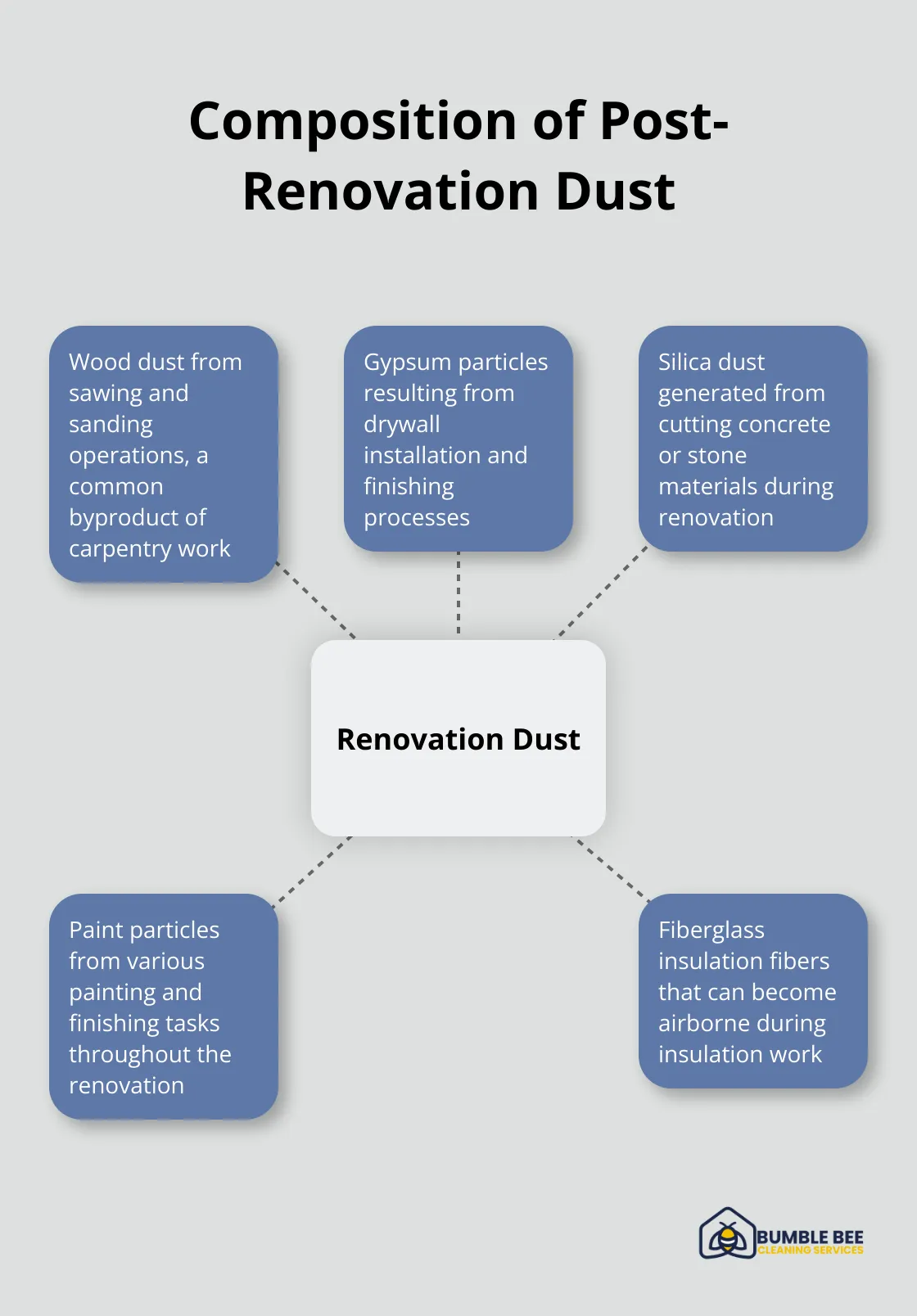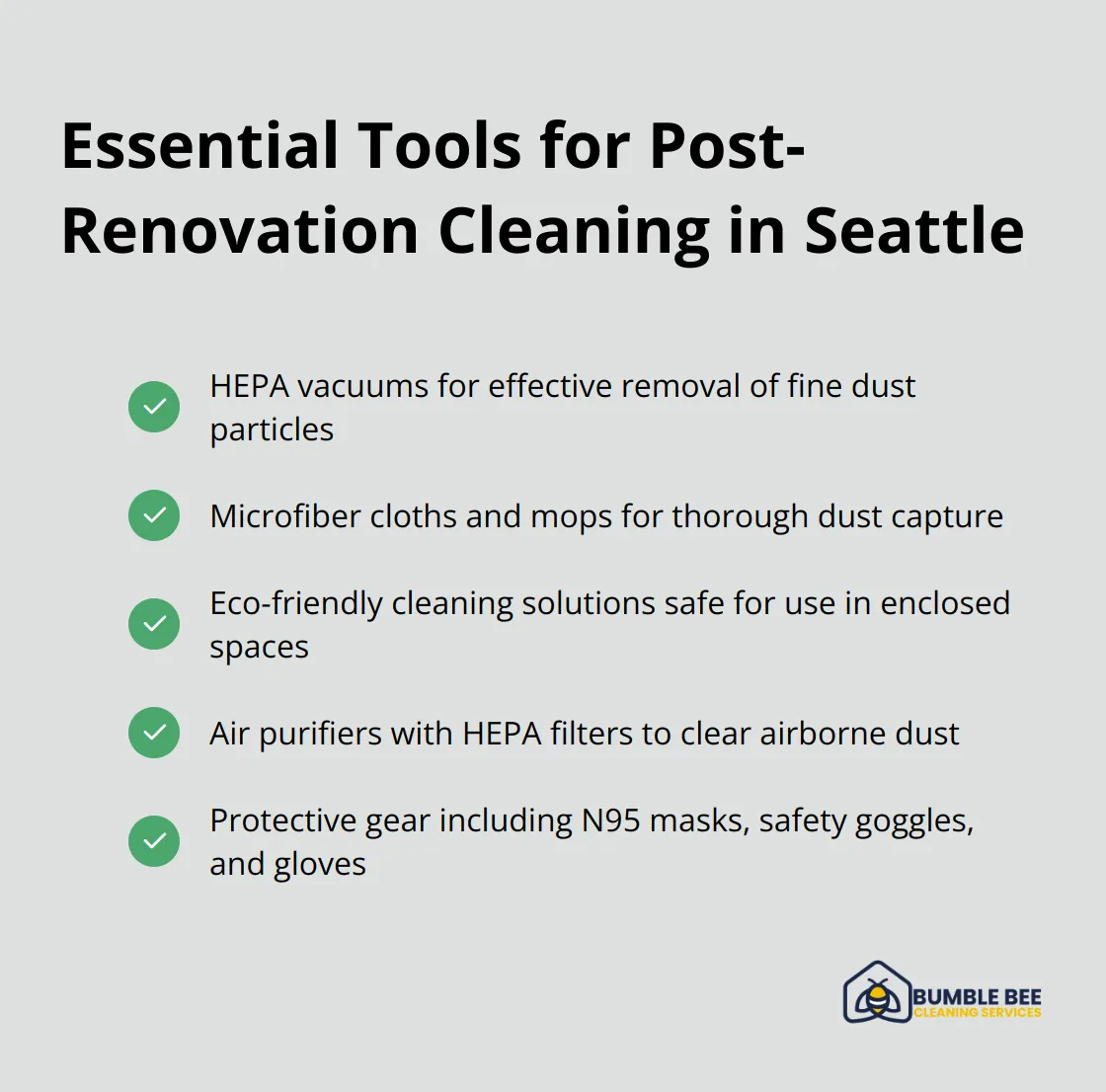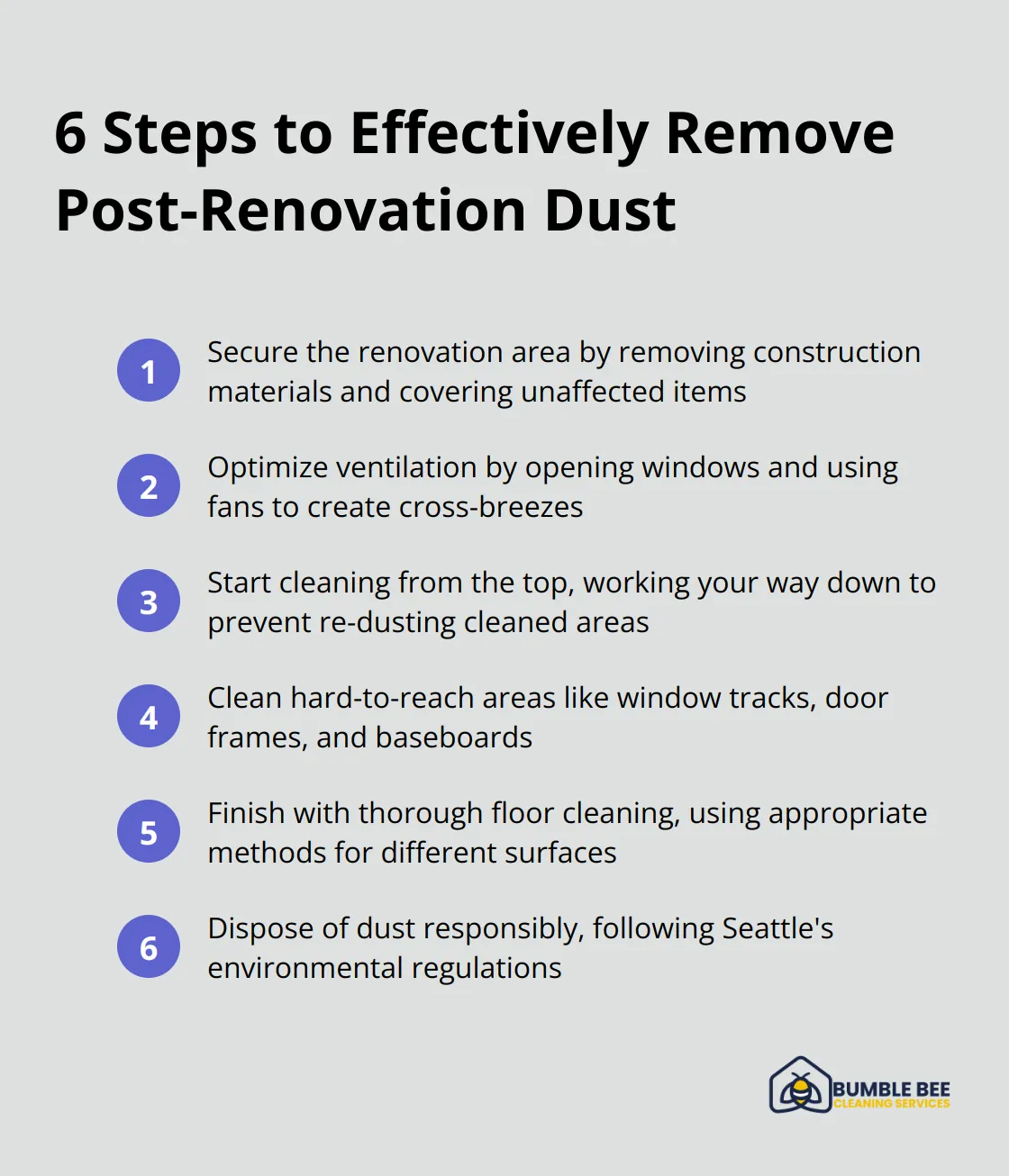Renovations can transform your Seattle home, but they often leave behind a challenging mess. At Bumble Bee Cleaning Services, we understand the unique challenges of construction cleanup in the Pacific Northwest.
This guide will equip you with professional techniques to tackle post-renovation dust effectively, ensuring a clean and healthy living space. Learn how to combat dust accumulation, protect your health, and maintain your newly renovated home like a Seattle pro.
What’s Lurking in Seattle’s Post-Renovation Dust?
The Composition of Renovation Dust
Post-renovation dust in Seattle homes contains a complex mixture of potentially harmful particles. Wood dust from sawing and sanding, gypsum particles from drywall work, and silica dust from cutting concrete or stone are common components. Paint particles and fiberglass insulation fibers also frequently appear in this mix.

Health Implications of Post-Renovation Dust
The health risks associated with post-renovation dust are significant. Inhalation of fine particles can irritate the respiratory system and potentially exacerbate conditions like asthma or allergies. OSHA standard 9 CFR 1926.1153 requires employers to limit worker exposure to respirable crystalline silica and take steps to protect workers.
Older homes in Seattle may contain lead-based paint, which, when disturbed during renovations, can release toxic lead dust. The Environmental Protection Agency (EPA) cautions that even small amounts of lead dust can harm children and pregnant women (a fact that underscores the importance of professional cleaning).
Seattle’s Climate and Dust Accumulation
Seattle’s unique climate significantly influences dust accumulation post-renovation. The damp climate of the Pacific Northwest creates unique challenges for maintaining a healthy living environment. Frequent rain can bring moisture indoors during renovations, potentially leading to mold growth if dust and debris remain uncleaned.
Effective Dust Management Strategies
To effectively manage post-renovation dust in Seattle homes, quick action is essential. Cleaning should start within 24 hours of completing renovations to prevent dust from settling deeply into surfaces. HEPA-filtered vacuums are indispensable tools, as they capture 99.97% of particles as small as 0.3 microns.
A top-to-bottom approach ensures no surface is overlooked. Special attention should focus on often-forgotten areas like light fixtures, window sills, and HVAC vents (prime spots for dust accumulation).
The Role of Professional Cleaning
While DIY cleaning can address surface-level dust, professional post-renovation cleaning services often provide a more comprehensive clean. Industrial-grade equipment and eco-friendly cleaning solutions specifically designed for Seattle’s unique climate can make a significant difference in the thoroughness of the cleaning process.
As we move forward, let’s explore the essential tools and products that make tackling post-renovation dust in Seattle homes more effective and efficient.
What Tools Do Seattle Pros Use for Post-Renovation Cleaning?
HEPA Vacuums: The Gold Standard for Dust Removal
High-Efficiency Particulate Air (HEPA) vacuums stand as the cornerstone of effective post-renovation cleaning. These powerful machines are able to remove small airborne particles in the size range of 0.1-1 μm, which makes them exceptionally effective at removing fine dust that lingers after renovations. The Environmental Protection Agency (EPA) recommends HEPA vacuums for their superior filtration capabilities, especially for removing potentially harmful particles (such as lead dust from older home renovations).
When you select a HEPA vacuum, look for models with strong suction power and multiple attachments to reach corners and crevices. Professional-grade HEPA vacuums can cost upwards of $500, but the investment pays off in thorough dust removal and improved indoor air quality.

Microfiber Magic: The Secret Weapon Against Dust
Microfiber cloths and mops are essential tools in any post-renovation cleaning arsenal. These ultra-fine synthetic fibers effectively remove grime and debris, even from tiny crevices.
For best results, use slightly damp microfiber cloths for dusting surfaces and dry microfiber mops for hardwood floors. Replace or wash microfiber tools frequently during the cleaning process to maintain their effectiveness.
Eco-Friendly Cleaning Solutions for Seattle Homes
Seattle’s commitment to environmental sustainability extends to cleaning practices. Eco-friendly cleaning solutions benefit the environment and provide safer options for use in enclosed spaces after renovations. Look for products certified by Green Seal or EcoLogo, which meet rigorous environmental standards.
For general cleaning, a mixture of white vinegar and water (1:1 ratio) can clean most surfaces effectively without harsh chemicals. For tougher jobs, consider using oxygen-based cleaners, which work well against stubborn stains and remain safe for most surfaces.
When you deal with specific materials like natural stone or hardwood, always use pH-neutral cleaners to avoid damage. The National Wood Flooring Association advises against water-based cleaners on hardwood floors to prevent warping.
Air Purifiers: Clearing the Air After Renovations
Air purifiers with HEPA filters play a vital role in post-renovation cleaning. These devices circulate and filter the air, removing airborne dust particles that vacuuming and dusting might miss. Look for air purifiers with a Clean Air Delivery Rate (CADR) appropriate for the room size you’re cleaning.
Protective Gear: Safety First in Post-Renovation Cleaning
Professional cleaners prioritize safety when tackling post-renovation dust. Essential protective gear includes:
- N95 respirator masks (to filter out fine dust particles)
- Safety goggles (to protect eyes from dust and cleaning solutions)
- Disposable gloves (to protect skin from harsh cleaning agents)
This protective equipment not only safeguards the cleaner but also prevents the spread of dust during the cleaning process.
As we move forward, let’s explore the step-by-step process of effectively removing post-renovation dust, putting these tools to work in a systematic approach that ensures no speck of dust is left behind.
How to Remove Post-Renovation Dust Effectively
Secure the Renovation Area
Before you start cleaning, remove any remaining construction materials. Cover furniture or fixtures that weren’t part of the renovation. This step prevents cross-contamination and protects your belongings from dust during the cleaning process.
Optimize Ventilation
Focus on ventilation next. Open all windows and doors to create a cross-breeze. Use box fans in windows to push dusty air outside. Run your HVAC system with a new filter to help capture airborne particles. Cover return air grilles in the work area to prevent dust from entering the system.
Start from the Top
Begin your cleaning from the ceiling and work your way down. Use an extendable duster or a HEPA vacuum with an extension wand to remove dust from ceiling fans, light fixtures, and the tops of cabinets. This method prevents dust from falling onto already cleaned surfaces.

For walls, use a damp microfiber cloth. For stubborn dust, mix a solution of warm water and a few drops of dish soap. Always test this solution on an inconspicuous area first to ensure it doesn’t damage the paint or wallpaper.
Clean Hard-to-Reach Areas
Don’t overlook often-forgotten spots like window tracks, door frames, and baseboards. These areas can harbor significant dust. Use a small brush attachment on your HEPA vacuum or a damp cloth wrapped around a putty knife to clean these narrow spaces effectively.
For electronics and delicate items, use compressed air cans to blow out dust, followed by a gentle wipe with a microfiber cloth. Never spray liquids directly onto electronic devices.
Finish with Floors
Clean floors last. For hard surfaces, use a microfiber mop with a pH-neutral cleaner. For carpets, start with a thorough HEPA vacuuming, followed by professional steam cleaning if necessary. Professional cleaning after renovations removes all construction debris, from large chunks to microscopic dust particles, transforming a work site into a livable or workable environment.
Dispose of Dust Responsibly
Proper disposal of dust and debris is important, especially in Seattle where environmental regulations are strict. Bag all dust and small debris before disposing of it in your regular trash. For larger amounts of construction waste, rent a small dumpster or use a junk removal service that adheres to local recycling guidelines.
Post-renovation dust can contain harmful particles. If you’re dealing with renovations in an older home or feel overwhelmed by the cleaning process, consider hiring a professional cleaning service. Professional cleaners have the tools and expertise to handle post-renovation cleaning efficiently and safely, ensuring your newly renovated space is clean, healthy, and ready to enjoy.
Final Thoughts
Post-renovation cleaning in Seattle demands a systematic approach and appropriate tools to combat dust and debris effectively. We recommend starting with proper ventilation, working from top to bottom, and focusing on often-overlooked areas. Regular cleaning routines using HEPA vacuums and microfiber cloths will help maintain a dust-free home after renovation.
Professional post-renovation cleaning services offer numerous benefits, saving you time and effort while providing peace of mind. At Bumble Bee Cleaning Services, we specialize in construction cleanup and use industrial-grade equipment to ensure thorough cleaning. Our team addresses even the most stubborn dust and debris, leaving your newly renovated space pristine and ready to enjoy.
Effective post-renovation dust removal plays a vital role in maintaining a healthy home in Seattle. You can choose to tackle the cleaning yourself or opt for professional services (which often yield superior results). Whichever option you select, thorough cleaning and ongoing maintenance will allow you to fully enjoy your newly renovated space, free from the lingering effects of construction dust.
